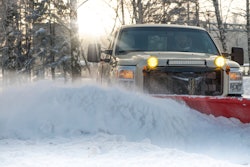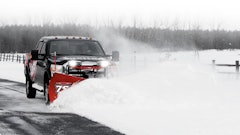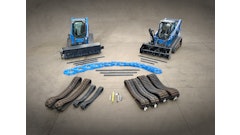
The best way for snow professionals to maximize their return on investment for a plow is to pick the right tool for all or most of their planned applications, according to Darin Gronwold, product specialist, Ignite Attachments.
“Whether it’s your application or your carrier, mismatching plows and other snow tools can lead to a number of challenges,” Gronwold says. “Chief among these is loss of productivity and therefore, profitability, but you also put your site, equipment and crews at risk.”
Gronwold and Erin Hunt, product manager at Douglas Dynamics, lay out what snow professionals need to know to properly select the plow that best suits their operation.
Plow types
1. Straight blade plow
Simple to operate, the straight blade plow easily moves up, down, left and right. Maintenance is minimal, so the plows tend to last longer and are usually the first type of plow purchased when snow professionals first get into the business, Hunt says.
2. V plow
V plows allow for more versatility as they help snow professionals break up ice, scoop snow and more, according to Hunt. This plow allows snow professionals to tackle a wide variety of snow conditions and property types.
3. Winged plow
A straight blade that includes an expansion of moving parts on the end, the winged plow enables the operator to move its wings to scoop snow more effectively. While it doesn’t boast the versatility of a V plow, Hunt says the operator can carry more snow and angle the plow so that less snow spills off.
4. Pusher plow or box plow
Pusher or box plows typically pair with a piece of equipment such as a skid-steer loader rather than a truck. Because these plows can stack and move a ton of snow, Hunt says these are ideal for larger areas such as parking lots, which can then free up truck plows to clear long driveways and subdivision roads.
Top considerations
1. Application
Pusher and box plows are ideal for large, open spaces like parking lots and farmyards, while other types of plows are better suited for a driveway, roadway or other applications that require more maneuverability.
Gronwold says that snow professionals should be aware of obstacles that may be hidden under snow, including curbs, manhole covers and other immovable objects.
While pusher blows don’t require hydraulics or hoses, straight blade plows or V plows are better suited for areas with for more confined spaces or obstacles because they use the carrier’s hydraulic connection to better control where the snow goes.
Whatever the case, Gronwold says operators should be sure to always wear their seatbelt and travel at a slower rate until they’re familiar with the area.
“Hitting hidden objects that are under the snow could injure the operator as well as damage your machine and attachment,” he says.
When examining a snow removal site, snow professionals should also consider how they want to disperse the snow, Gronwold says.
For example, will the snow be simply pushed to the side or piled in a central location for later removal or until warmer temperatures melt it? For work along roadways or sidewalks, a straight blade of V blade allows the snow to be pushed out of the way or into windrows for easier collection, while a pusher or box plow can only move snow straight ahead.
“In terms of application, opting for a snow pusher on a driveway or a plow in a parking lot leads to inefficient snow piling. You’ll either end up making more passes, bringing in more equipment, or having to do some of the detail work by hand,” Gronwold says. “All of these eat into your efficiency and bottom line.”
2. Carrier equipment
In addition to application, it’s also important to properly match your snow removal attachment to the truck or piece of equipment.
“If your plow is too big, meaning too heavy or too long, it can really damage your vehicle,” Hunt says. “If it’s too small, it can damage the plow, and it’s not going to be the right fit for getting the job done. There are quite a few tools online to help customers decide which plow is appropriate.”
Gronwold provides additional tips for matching the plow to the carrier equipment:
- When selecting the correct size for your compact tractor, skid-steer or compact track loader, make sure the snow pusher is wider than your carrier.
- Make sure you have enough tractive effort and horsepower to push the larger volume of snow. Typically, 6- and 7-foot snow pushers are used on compact tractors and smaller skid-steers. An 8-foot snow pusher requires a minimum of 40 hp, while a 10-foot option needs roughly 70 hp, making these a better fit with larger loaders.
- Angled blades and V plows should slightly wider than the carrier to prevent driving over snow windrows. These tools don’t typically need to carry as much snow at a time, so you need less tractive effort and horsepower unless you are operating in an area prone to heavy, wet snow.
- For compact tractors, look for three-point angle blades that attach to the three-point hitch.
3. Durability and maintenance
Because snow is heavy and salt and de-icing materials can be corrosive, it’s important to choose a plow that is durably made.
Hunt says that the moldboard or blade can be made out of materials such as stainless steel, painted steel and polyurethane—each with its own price point.
“Each of those types of material have different features and advantages,” Hunt says. “People say that stainless steel looks nicer and lasts longer, while polyurethane is a little bit gentler on the property. It’s really just personal preference.”
Gronwold notes that models with high-quality steel and corrosive-resistant coatings will stand up better to winter elements.
Finally, it’s important to look for manufacturers that offer reversible and replaceable skid shoes to extend equipment lifespan, according to Gronwold.
For blades, look for a hardened steel cutting edge and adjustable spring-loaded blade trip to protect the attachment and equipment from snow-covered obstacles and pavement edges. Blade guide markers are also recommended with snow plows for better visibility and precision when clearing snow, Gronwold says.













![Kubota Snow ah3 Sgv25ua[1]](https://img.greenindustrypros.com/mindful/acbm/workspaces/default/uploads/2025/10/kubota-snowah3sgv25ua1.bAUoUSziui.png?ar=16%3A9&auto=format%2Ccompress&bg=fff&fill-color=fff&fit=fill&h=135&q=70&w=240)






